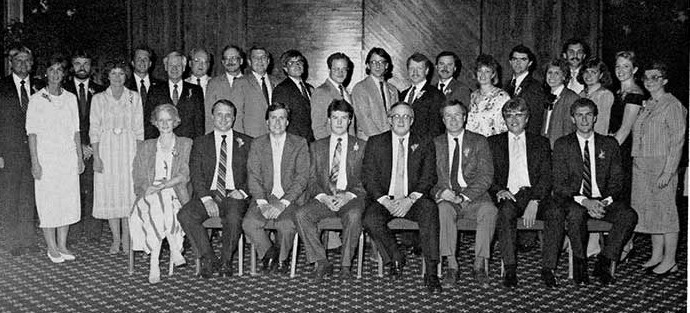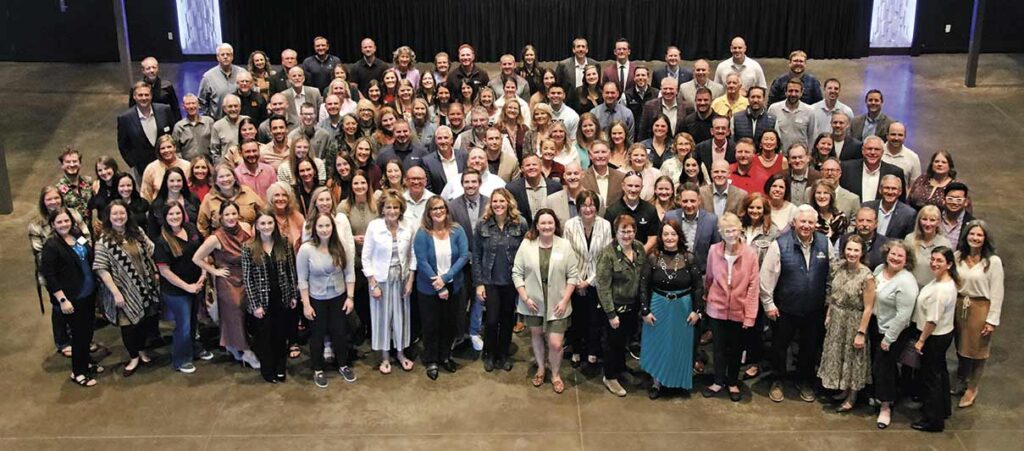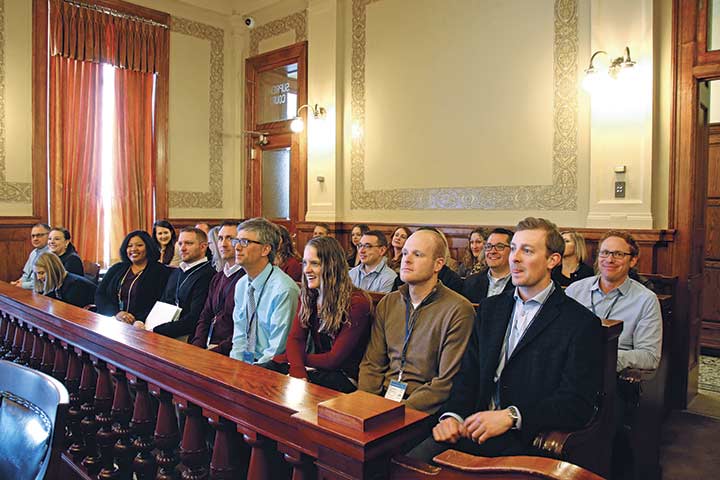
Leadership Sioux Falls at 40 years: Investing in Community Leadership
In 1986, the Greater Sioux Falls Chamber of Commerce identified a critical need: ensuring the long-term success of the Sioux Falls region by preparing a pipeline of informed, engaged and empowered community leaders. From that vision, the Evan C. Nolte Leadership Sioux Falls (LSF) program was born.
Now, four decades later, the program stands as a testament to what can happen when business and civic leaders invest in people. The 40th class will start this fall, joining more than 1,100 alumni who have completed the immersive, months-long journey to becoming better community leaders. The legacy of the program can be found across Sioux Falls—in boardrooms, nonprofits, classrooms, neighborhoods and even the halls of government.
Ben Dold, a member of Class 30 and President and COO at Midco, emphasized the deeper understanding and lasting connections the program fosters. “By learning from the impact made by generations before them, each class has the opportunity to carry that forward.”
“The network created within each class is valuable for years to come in the business community,” he added. “The broader network and the shared understanding of the culture of the business community both contribute to the overall success of Sioux Falls.”
Founding and Early Years
The origins of Leadership Sioux Falls trace back to conversations sparked by Jerry Simmons, a local business leader and entrepreneur. Simmons had observed other chambers across the country starting leadership development initiatives and believed Sioux Falls should do the same. With support from the Chamber’s Executive Committee and then-Chair Mark Griffin, Owner and CEO of Lewis Drug, Inc., the idea gained momentum.
Evan Nolte, who served as President of the Chamber when the program launched and for whom the program is now named, described some of the early challenges: designing a selection process, establishing a curriculum, and assembling a team to implement the program. Kate Foley, a Chamber staff member, helped guide the logistics, while a community-based advisory committee brought credibility and connection to the effort. Foley would go on to serve as the program’s longtime coordinator, guiding it through much of its 40-year history.
From the outset, interest in the program was strong. Even in its earliest days, the number of applicants far exceeded the available slots, with the inaugural class consisting of 30 participants. That competitive selection process helped establish the program’s prestige, a reputation that continues today. The cohort has since grown to 37 participants each year, who engage in a series of monthly sessions from October through April, culminating in a
graduation ceremony in May. The curriculum evolves annually to reflect the changing needs and priorities of the Sioux Falls community.
This ability to adapt and grow alongside the community has been a key factor in Leadership Sioux Falls’ lasting success. As Nolte observed, “One of the many strengths of the program is the ability to adjust the programming or curriculum based on changes and the emergence of important issues affecting the community and area.”

Curriculum with Community at Its Core
Leadership Sioux Falls is not an academic exercise. It is intentionally experiential, using the community itself as the classroom. Participants visit key organizations, hear from local experts and leaders, and explore complex issues such as public safety, education, healthcare, transportation and economic development.
Dennis Feterl, Vice President, Treasury at First PREMIER Bank and member of class 20 had just moved to Sioux Falls before joining the cohort. “Leadership Sioux Falls gave me exposure to the culture of the city and the leaders that impact it,” he said, stating that it was an informational foundation that set his direction for leadership success.
The Leadership Sioux Falls curriculum is designed to provide a comprehensive experience that builds connections and understanding of the community. Early sessions focus on team building and getting to know one another, followed by an in-depth exploration of Sioux Falls’ history and key organizations, including panels on economic development and Chamber involvement. Participants also experience a city bus tour to gain firsthand insight into Sioux Falls.
“As a lifelong South Dakotan, I thought I had a lot of knowledge about this area,” said Lindsey Meyers, Vice President of Public Relations, Communications and Community Engagement for Avera and member of class 30. “However, Leadership Sioux Falls taught me so much about the history that formed Sioux Falls, how city and state government works together and the roles that so many play.”
Subsequent sessions focus on education and government. Participants meet with the mayor, hear from school district leaders and engage with county commissioners while
learning about workforce development strategies. Public safety is explored through visits with the Minnehaha County Sheriff’s Office, a tour of the County Jail and facilitated discussions on law enforcement and community needs.
The Chamber’s annual Sioux Falls Day at the Legislature brings participants to Pierre, offering a unique window into the state’s legislative process. The business and industry session showcases employers across the healthcare, agriculture, financial and manufacturing sectors.
A final focus on service introduces participants to organizations like the Sioux Falls Area Community Foundation, Sioux Empire United Way and Helpline Center. Practical sessions on volunteerism and nonprofit board literacy prepare graduates to contribute meaningfully to the community.
“Community involvement proves to be the center of Sioux Falls growing success,” Feterl noted. “Leadership Sioux Falls is foundational for new leaders to learn that early in their career and take it forward for themselves and others to see.”
Over the years, the program has adapted to reflect the city’s evolving needs. Enhancement sessions—optional opportunities added in recent years—further immerse participants in the workings of the community. These sessions have included hard hat tours of construction sites, observing proceedings in Minnehaha County Treatment Court, policy workshops, visits to new community facilities and volunteering at various nonprofits.

Lifelong Impact and Connection
Participants frequently describe their experience in Leadership Sioux Falls as both eye-opening and transformative. The impact goes far beyond any one session or speaker—it’s the relationships formed and the inspiration to take action that make a lasting impression on alumni.
Dold shared that, as someone who didn’t grow up in Sioux Falls, the program was especially meaningful. “The program provided me valuable insights into the history of the
business community, what makes Sioux Falls so special, and created lasting connections to my peers and the program leaders.”
He also highlighted a key message he took from the program: “It is an expectation for business leaders in Sioux Falls to support the broader community and one another. I’ve seen it in action and I’m grateful to have learned this lesson when I did.”
From civic boards and charitable organizations to public service and mentorship, Leadership Sioux Falls alumni contribute across every sector. Forty-eight Leadership Sioux Falls graduates have served on the Chamber board of directors, and others have gone on to elected office. City councilors, county commissioners and even a South Dakota governor—Dennis Daugaard—are among the program’s alumni.
Daugaard, a member of class 4, continues to value the connections he made. “I met many others with whom I developed a friendship that has lasted many years,” he said. “Relationships are important in one’s leadership journey, and Leadership Sioux Falls adds key relationships to participants, even as it provides lessons in leadership.”
Alumni Leadership and Ongoing Engagement
Since its founding, LSF has produced more than 1,100 graduates. Many have gone on to serve on nonprofit boards, advisory committees and Chamber leadership roles. Alumni often credit the program for expanding their understanding of how Sioux Falls operates and motivating them to get involved in new ways.
Alumni engagement doesn’t stop at graduation. Many classes continue to meet informally or collaborate on projects. Some graduates return to serve on the program’s Executive Committee, guiding curriculum development and selecting future classes. Most recently, alumni were invited to celebrate the 40th anniversary of the program, reconnect with classmates and make new connections with other alumni—an opportunity that more than 200 previous participants took advantage of.

Looking Ahead
The Sioux Falls region continues to grow at a remarkable pace. As the community expands, so does the need for thoughtful, collaborative leadership. Challenges related to infrastructure, housing, workforce development and public safety requires leaders who are prepared to listen, adapt and take action. Leadership Sioux Falls plays a vital role in preparing individuals to meet those challenges and help shape the region’s future.
“I have every confidence that current and future leadership will continue to address new goals as our community grows,” said Nolte.
The Chamber’s commitment to the program remains strong, as does its belief in the power of people. Leadership Sioux Falls continues to identify and elevate emerging leaders who care deeply about their community and are ready to make a difference.
As the program celebrates 40 years, its mission is more relevant than ever: to prepare individuals to lead not just in their jobs, but in their neighborhoods, schools and civic spaces. In doing so, it helps ensure that the Sioux Falls of tomorrow remains as connected, collaborative and resilient as it is today.
“We often think we’re just one person—what kind of a difference can we make?” said Meyers. “Working together, seeing others’ viewpoints and caring about common goals can shape ideas over time. Relationships matter.”